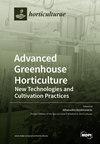Non-Structural Carbohydrate Content and C:N:P Stoichiometry in Houpoea officinalis Flowers in Response to Development Stages
IF 3.1
3区 农林科学
Q1 HORTICULTURE
引用次数: 0
Abstract
Mineral elements and non-structural carbohydrates (NSCs) are important nutrients and energy sources for flower development in plants. However, no studies were reported on the dynamic changes of nutrient stoichiometry and NSC contents in Houpoea officinalis (H. officinalis) flower. In this study, the changes in carbon (C), nitrogen (N), phosphorus (P), and NSC contents as well as C:N:P stoichiometry in the pistil, stamen, and petal of H. officinalis flowers at four developmental stages were comparatively analyzed. The results showed that C, N, P, and NSC contents, as well as C:N:P stoichiometric ratios in the three parts of the flower exhibited large variations at four development stages. Development stages and organs had significant effects on the measured parameters in the three organs of H. officinalis flowers, but their interactions had no significant effects. During the flower development, C, N, and P contents in different floral parts ranged from 418.7 to 496.3 mg/g, 26.6 to 45.3 mg/g, and 0.396 to 0.656 mg/g. P content decreased continuously with development, C:N in stamen were significantly higher than those in other flower parts at the same developmental stage. Glucose, starch, fructose, and sucrose contents showed significant differences in three parts of H. officinalis flowers at four development stages. These differences may reflect differences in elemental storage capacity and biomass allocation patterns of H. officinalis flowers. In general, our data will help to improve our understanding of the relationship between NSCs and C:N:P stoichiometry in response to development stages and organs in H. officinalis flowers.厚朴花中的非结构性碳水化合物含量和 C:N:P 的比例随发育阶段而变化
矿质元素和非结构性碳水化合物是植物花发育的重要营养物质和能量来源。然而,目前还没有关于欧芹(Houpoea officinalis)花中养分配比和非结构性碳水化合物含量动态变化的研究报道。本研究比较分析了雌花、雄蕊和花瓣四个发育阶段中碳(C)、氮(N)、磷(P)和 NSC 含量的变化以及 C:N:P 的比例关系。结果表明,在四个发育阶段,花的三个部分的C、N、P和NSC含量以及C:N:P的化学计量比变化很大。发育阶段和器官对欧芹花三个器官的测量参数有显著影响,但它们之间的交互作用没有显著影响。在花的发育过程中,不同花朵部位的 C、N 和 P 含量分别为 418.7 至 496.3 毫克/克、26.6 至 45.3 毫克/克和 0.396 至 0.656 毫克/克。P含量随着发育持续下降,雄蕊中的C:N含量在同一发育阶段明显高于其他花朵部位的C:N含量。葡萄糖、淀粉、果糖和蔗糖的含量在 H. officinalis 花的三个部分的四个发育阶段均有显著差异。这些差异可能反映了 H. officinalis 花的元素储存能力和生物量分配模式的不同。总之,我们的数据将有助于我们更好地理解 NSC 与 C:N:P 的化学计量之间的关系,以及 H. officinalis 花朵对发育阶段和器官的响应。
本文章由计算机程序翻译,如有差异,请以英文原文为准。
求助全文
约1分钟内获得全文
求助全文

 求助内容:
求助内容: 应助结果提醒方式:
应助结果提醒方式:


